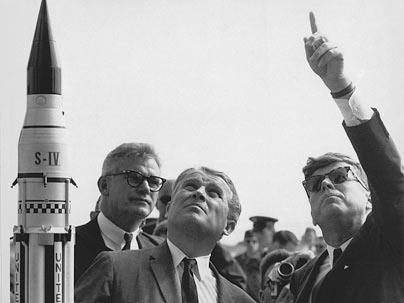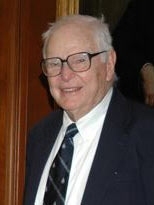Robert C. Seamans Jr., an MIT alumnus who was a leading NASA administrator during the Apollo program, the ninth secretary of the U.S. Air Force and the dean of MIT's School of Engineering from 1978-81, died on June 28. He was 89.
Seamans, who received his MS in aeronautics from MIT in 1942 and his ScD in instrumentation in 1951, served in several major administrative roles both in the government and at MIT.
Widely credited with helping the U.S. put men on the moon, Seamans held roles as Associate Administrator and Deputy Administrator with NASA during the Apollo program. He was also the first administrator of the Energy Department and a former president of the National Academy of Engineering (NAE).
Seamans served as an instructor, assistant professor and associate professor in the Department of Aeronautical Engineering from the early 1940s through 1955. He also worked as a project leader in the Instrumentation Lab, a chief engineer for Project Meteor and as a director of the Flight Control Lab.
The one period of Seamans' life spent away from academia or the government--from 1955-1960--landed him at RCA, where he was chief engineer of the company's Airborne Systems Lab and was the Missile Electronics and Controls Division chief engineer.
Seamans served on technical committees of NASA's predecessor, NACA, or the National Advisory Committee for Aeronautics, from 1948 to 1958. He served as a consultant to the Scientific Advisory Board of the United States Air Force from 1957 to 1959, and was the Secretary of the Air Force from 1969 to 1973.
He joined NASA in 1960 as an associate administrator, jumping up to deputy administrator five years later. At NASA, he worked on research and engineering programs in cooperation with the Department of Defense.
Upon his return to MIT in 1968, Seamans was named the Jerome Hunsaker Visiting Professor. After another hiatus spent at the Air Force and NAE, he again came back to Cambridge, but this time as the Luce Professor.
Seamans was named the dean of the School of Engineering in 1978--a post he would leave three years later--where he focused his efforts on laying the foundations of a proposed academic program in the management of technology. He wrote in his memoir, "Aiming at Targets," that he encountered a student in 1992 still in the program he worked to create. "It was gratifying for me to find that the program was still alive and prospering," he wrote.
He officially retired from the Institute in 1984, but served as a senior lecturer in the Department of Aeronautics and Astronautics until 1996.
In honor of his dedicated work to the field, a part of the Aero-Astro Learning Lab was named in Seamans' honor--The Robert C. Seamans Jr. Laboratory. At the time of the dedication, Seamans recalled doing "my work in Building 33 right under what today is the Learning Laboratory. I can't be more excited than to have that complex named for me--I never anticipated it."
Seamans was also the director of the Charles Stark Draper Laboratory and was on the board of trustees for the Museum of Science, the Woods Hole Oceanographic Institute, and the Carnegie Institution. A tall ship used in the SEA Semester at Woods Hole is also named in Seamans' honor.
In addition to his MIT degrees, Seamans received the BS from Harvard in 1940.
Memorial services will be held at 11 a.m. on Wednesday, July 1 at St. John's Episcopal Church in Beverly Farms, Mass. There will be a memorial service at a time to be announced at Harvard in the Memorial Church.






